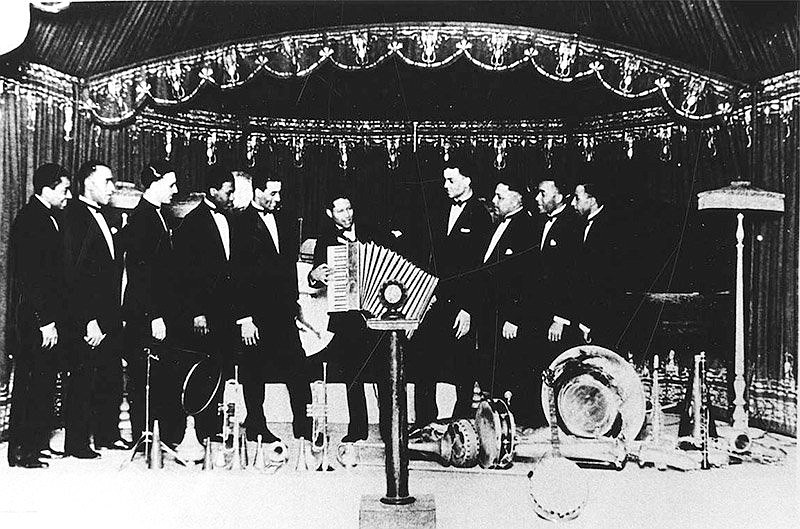Alphonso E. "Phonnie" Trent was a nationally renowned jazz pianist and band leader from Fort Smith. He led the Alphonso Trent Orchestra, a group of young Black musicians who toured the country; made several recordings; and had a lengthy engagement at the Adolphus Hotel in Dallas. During that engagement, the band became the first group of Black musicians to be featured on regional broadcasts over WFAA radio in Dallas.
Alphonso Trent was born in Fort Smith on Oct. 24, 1902, the son of E.O. Trent and Hattie S. Smith. Trent's father was one of the first Black graduates of Ohio State University and served as principal of Fort Smith's Lincoln High School. Trent began his musical education at an early age. While still in his teens, he gained valuable experience as a pianist working around western Arkansas and eastern Oklahoma in Sterling Todd's Rose City Orchestra and the Quinn Band. Because his father was a prominent educator, Trent received a strong classroom education and, in the fall of 1923, began attending Shorter College in North Little Rock.
Shortly after arriving in Little Rock, he began playing piano with a group led by Eugene Crooke, called the Syncho Six. However, because of Trent's strong musical leadership and his skill at booking engagements, the band's name was changed to the Alphonso Trent Orchestra. In spring 1925, the band set out for Texas, playing street corners for nickels and dimes and an occasional dance engagement.
A bellman from the Adolphus Hotel heard Trent's orchestra at a dance and convinced the hotel's manager to book the group for a two-week engagement in the hotel's second ballroom. This was soon extended into an 18-month engagement, during which the orchestra received exposure through broadcasts over the 50,000-watt radio station, WFAA.
Trent's broadcasts from the Adolphus were the first for a Black orchestra and reached an audience throughout the central United States and Canada. The orchestra even performed at the inaugural ball of Texas' first female governor, Miriam A. Ferguson.
During the long engagement at the Adolphus, the band grew to 11 musicians. All members received the same pay and were expected to contribute ideas to the development of the musical arrangements. Under Trent's musical direction, the band emphasized good tone quality (actual tone or timbre of the instruments), intonation (tuning of notes and chords), and showmanship.
While in Dallas, Trent married Essie Mae Grissom, whom he had met at a party held in the band's honor. The couple never had children, but Trent had previously had a son, Alphonso B. Trent, born in 1922 to a woman in Fort Smith.
From summer 1926 to October 1927, Trent's orchestra toured major hotels throughout Texas, Arkansas, Louisiana and Mississippi. For the next two years, the Alphonso Trent Orchestra played in Cincinnati; Louisville and Lexington, Ky.; Buffalo, N.Y.; and other cities. During this time, the band made its first recordings, four songs for the Gennett Company in Richmond, Ind.
In summer 1929, the Alphonso Trent Orchestra performed at a resort in Port Stanley, Ontario. At the close of the engagement, the band headed for its one and only date in New York, a two-week stint at the Savoy Ballroom. At the end of the two weeks, Meyer Davis offered Trent an extended run at the Arcadia Ballroom, but he refused, opting instead for a higher-paying job at the Plantation Club in Cleveland.
During the engagement in early 1930 at the Plantation Club, a fire of suspicious origins consumed the establishment and destroyed the orchestra's instruments and library. Trent's family came to the rescue, buying new instruments for the group. Jobs during the Great Depression were scarce, and the band hobbled back to Fort Smith. Trent kept his musicians busy, however, using his hometown as a base of operations.
The Alphonso Trent Orchestra made one last road trip in the winter of 1932-'33, but Trent did not accompany them. Soon, however, he had another band on the road, a small group touring the Dakotas, Wyoming, Colorado and Texas during the 1930s and early 1940s. He continued to promote young musical talent, including pioneering jazz guitarist Charlie Christian.
After World War II, Trent settled permanently in Fort Smith to manage the family's real estate holdings and, beginning in 1953, the city's first housing project, Elm Grove Homes. He remained active in the music business but restricted his performances to local nightclubs.
Trent died of a heart attack in Fort Smith on Oct. 14, 1959. He is buried in the city's Oak Cemetery.
— Henry Q. Rinne
This story is adapted by Guy Lancaster from the online Encyclopedia of Arkansas, a project of the Central Arkansas Library System. Visit the site at encyclopediaofarkansas.net.

